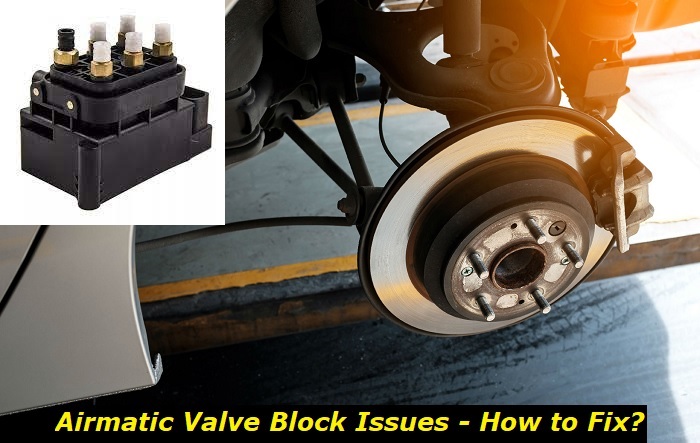Mercedes vehicles are renowned for high-class engineering, comfort, and luxury. One of the factors responsible for the comfort and smooth handling of a Mercedes is the responsive and self-leveling Airmatic suspension system. This system adds a level of control by allowing the driver to raise and lower the car at the push of a button, improving aerodynamics or clearance as needed. When the Airmatic system starts to feel less responsive, then you may have a bad Airmatic valve block to blame.
Air suspension problems highlights
- Level of importance:medium
- Common reasons:internal suspension failure, electronic problem
- DIY inspection:impossible
- DIY repair:impossible
- Average price in shops:$550 - $1,900
- Average time:5 - 20 hours
- If ignored:fatal failure, car drops, hard driving

What Does the Airmatic Valve Block Do?
Airmatic valve blocks are typically found in Mercedes vehicles with air suspension systems, which use compressed air to support the weight of the vehicle. These types of systems offer a higher level of adjustability and comfort compared to traditional spring-based suspension systems.
The valve block is typically located near the air springs and is connected to the air compressor, which pumps air into the air springs to raise or lower the suspension. It also connects to the pressure reservoir. The valve block can be controlled by the vehicle's onboard computer or by a manual switch, allowing the driver to adjust the suspension for different driving conditions or load capacities.
Overall, the Airmatic valve block plays a crucial role in a vehicle's suspension system, allowing the driver to adjust the suspension's height and firmness for different driving conditions and load capacities.
Symptoms of a Bad Airmatic Valve Block
There are a few symptoms that can be noticed when the valve block goes bad. The Airmatic valve block is a crucial component in the suspension system, and a problem with it will result in overt changes to the way the vehicle handles and feels.
Most of the symptoms that you would notice with a bad air spring can also point to a bad valve block. Here are some of the symptoms you will notice when the Airmatic valve block has gone bad.
- Ride height issues
If the Airmatic valve block is not functioning properly, it can cause the ride height of the vehicle to be uneven or to fluctuate. This can result in the vehicle leaning to one side or the other, or the front or rear of the vehicle sitting too high or too low.
You might also notice issues with the level adjustment. The car might rise or lower slower than usual. You may also notice that after raising the car, it immediately begins to lower itself back down.
- Suspension problems
A malfunctioning Airmatic valve block can cause problems with the suspension that can be felt as you drive. If the air springs are no longer able to hold pressure, you may notice the vehicle has poor handling and is no longer able to absorb impacts like it used to. This can also be felt as rough idling, or the car rattling when passing or bumps or rough terrain.
- Air suspension warning light
Many vehicles equipped with air suspension systems have a warning light on the dashboard that indicates when there is a problem with the system. If the Airmatic valve block is no longer functioning properly, then this warning light may be illuminated.
What Causes a Bad Airmatic Valve Block
A bad Airmatic valve block is an annoying problem that can result in a bumpy ride, or even in your car being too rough to drive. The first step to fixing it is to troubleshoot the issue and identify the origin of the problem.
Here are some of the main causes of a bad Airmatic valve block.
- Leaking Valves
The main cause of a bad airmatic valve block is leakage. The main function of the valve is to control the airflow from the air springs, compressor, and pressure reservoir. If one of the valves is leaking, then the valve block won't be able to maintain the pressure in that part of the system. This can result in the air springs being unable to keep the car lifted, or the air lines being overpressurized, which can damage the compressor.
Physical damage to the valve block or a broken valve can cause a leakage that prevents the system from staying pressurized.
- Dirty or Damaged Solenoid Valves
The solenoid valves can get jammed through physical damage, or from dirt that manages to enter the air suspension system. The valves can also break down as a result of physical wear. When this happens, the valve will get stuck in either the open or closed position, which prevents it from adjusting the pressure in the airlines.
- Electrical Issues
The valve block adjusts the ride height and spring stiffness based on signals it receives from the computer. A problem in the electrical connection will result in problems with the valve block.
These problems might be present as short circuits or burnt-out wiring, as well as faulty wiring connections.
How to Fix a Bad Airmatic Valve Block
Fixing a bad Airmatic valve block is important because it allows you to get the air suspension working again, but it also helps to prevent further damage. A bad valve block can result in damage to the compressor.
A car should not be driven with a bad Airmatic system. When the suspension is starting to fail, the handling of the car will no longer be reliable, compromising the safety of the driver and passengers. Any impacts that the car experiences will not be absorbed by the suspension but will be transferred directly to the chassis of the car, which may cause further damage.
Fixing the Airmatic valve block is a complicated process that may involve removing a wheel and opening the cover of the wheel well. It requires the vehicle to be supported with a jack as you work under it and can be dangerous if you don't have sufficient experience. If you are inexperienced with automotive repair, it is recommended that you have a professional handle this for you.
- Check the Air Springs and Air Lines
Even though the main concern here is the Airmatic valve block, it is important to ensure that the problem isn't coming from another part of the air suspension. You can examine the air springs and air lines by listening for a hissing sound and rubbing them with soapy water. You will notice soap bubbles forming wherever a leak is present.
If you find any leaks, replace the faulty part first and observe whether the symptoms have disappeared.
- Examine the Electrical Connections
To search for problems with the Airmatic valve block's electrical connections, you will need to inspect the wiring that connects to it. Replace any damaged or broken wiring that you find. If there are any loose connectors, reinsert them or tighten them as needed.
- Replace the Airmatic Valve Block
If the valve block is damaged or faulty, it will need to be replaced. This can be done at an authorized dealership or automotive repair professional. If you choose to replace it yourself, you will need to purchase a replacement valve block. While they are available online at a relatively cheap price, you will need to ensure that you get an exact replacement to avoid compatibility issues. Arnott also produces aftermarket valve blocks that are suitable for Mercedes vehicles.
When replacing the valve block, it is also worth examining the compressor. When the valve block is stuck in an open position, it can result in the overpressurization of the air lines. This causes high pressure in the compressor, which can damage it and cause it to burn out over time.
Conclusion
Mercedes Airmatic suspension system is a useful work of engineering that ensures a smooth ride that is adjustable for a variety of terrain and load conditions. A bad Airmatic valve block can be a serious issue for the air suspension system. It can cause ride height issues, suspension problems, and a warning light on the dashboard, all of which can negatively impact the comfort and handling of the vehicle, or even compromise the safety of the driver.
To fix these issues, it is important to properly diagnose the problem and determine whether the Airmatic valve block is the cause. It is important to check for other problems with the air suspension system, like the air lines and the air springs. If the valve block is faulty, then it will need to be replaced. The compressor should also be checked, as a faulty valve block could cause damage to the compressor.
By addressing these issues on time, you can ensure that your vehicle's Airmatic system continues to run smoothly and prevent any further damage to the vehicle.
About the authors
The CarAraC research team is composed of seasoned auto mechanics and automotive industry professionals, including individuals with advanced degrees and certifications in their field. Our team members boast prestigious credentials, reflecting their extensive knowledge and skills. These qualifications include: IMI: Institute of the Motor Industry, ASE-Certified Master Automobile Technicians; Coventry University, Graduate of MA in Automotive Journalism; Politecnico di Torino, Italy, MS Automotive Engineering; Ss. Cyril and Methodius University in Skopje, Mechanical University in Skopje; TOC Automotive College; DHA Suffa University, Department of Mechanical Engineering






Add comment